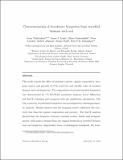Characterization of woodstove briquettes from torrefied biomass and coal
Date
2019-01-18Author
Trubetskaya, Anna
Leahy, James J.
Yazhenskikh, Elena
Müller, Michael
Layden, Peter
Johnson, Robert
Ståhl, Kenny
Monaghan, Rory F.D.
Metadata
Show full item recordUsage
This item's downloads: 455 (view details)
Cited 31 times in Scopus (view citations)
Recommended Citation
Trubetskaya, Anna, Leahy, James J., Yazhenskikh, Elena, Müller, Michael, Layden, Peter, Johnson, Robert, Ståhl, Kenny, Monaghan, Rory F. D. (2019). Characterization of woodstove briquettes from torrefied biomass and coal. Energy. doi:10.1016/j.energy.2019.01.064
Published Version
Abstract
Using waste biomass materials offers the potential to reduce the greenhouse gas emissions from fossil fuels. Torrefaction is very useful for improving the fuel properties of biomass in order to better match those of coal. The aim of this work is to compare the properties of torrefied low quality biomass briquettes against coal equivalents. The composition of the briquettes was characterized by 13C CP/MAS, proximate analysis, and X-ray diffraction and the results were compared with equilibrium calculations. In addition to these techniques, we report for the first time on the use of XμCT for characterizing such materials. The XμCT analysis showed that the briquette structure contains carbon, binder and inorganic matter, with quartz retained from the original feedstock in torrefied biomass and coal briquettes. The CO2 reactivity of pulverized briquettes was investigated by thermogravimetric analysis. Results showed that the inorganic matter influences the reactivity less than the organic composition and porosity. Importantly from a technological standpoint, the increase in binder concentration and replacement of starch with resin binder did not influence the reactivity and calorific value of a pulverized briquette.


